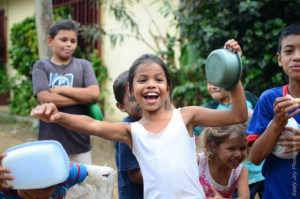5 Ways to Fight Hunger in Nicaragua
 Nicaragua, although having made tremendous progress in recent years, is still one of the poorest and least developed countries in Latin America. According to the World Bank, 24.9% of Nicaraguans lived in poverty as of 2016. Of those people, 200,000 lived in extreme poverty making less than $1.90 a day. As a result of poverty and harsh climate conditions, hunger in Nicaragua is a prominent issue. Even though approximately 70% of the population works in agriculture, 300,000 people still require food aid. Located in what’s known as the Dry Corridor, Nicaragua faces erratic weather patterns prone to climate shocks that are consistent threats to stable food production. However, in spite of the unfavorable conditions, many organizations and programs are on the ground working to fight hunger in Nicaragua.
Nicaragua, although having made tremendous progress in recent years, is still one of the poorest and least developed countries in Latin America. According to the World Bank, 24.9% of Nicaraguans lived in poverty as of 2016. Of those people, 200,000 lived in extreme poverty making less than $1.90 a day. As a result of poverty and harsh climate conditions, hunger in Nicaragua is a prominent issue. Even though approximately 70% of the population works in agriculture, 300,000 people still require food aid. Located in what’s known as the Dry Corridor, Nicaragua faces erratic weather patterns prone to climate shocks that are consistent threats to stable food production. However, in spite of the unfavorable conditions, many organizations and programs are on the ground working to fight hunger in Nicaragua.5 Initiatives to Fight Hunger in Nicaragua
- The World Food Program (WFP) offers various programs and services to alleviate hunger in Nicaragua. Since 1971, WFP has implemented strategies to improve food security. By supporting the National School Meal Program, the organization helped provide meals to more than 182,000 schoolchildren in April of 2020. Following a five-year plan that spans from 2019 to 2023, WFP aims to find long-term solutions to hunger in Nicaragua. Along with direct food assistance, WFP promotes creating efficient and sustainable agricultural practices by providing technical assistance in implementing weather-resilient farming methods, improving degraded ecosystems and developing technology for accurate climate information.
- The organization Food for the Hungry believes that chickens can be a catalyst for solving hunger. Food for the Hungry stated that chickens rank close to the top of its annual gift catalog because of their uses in decreasing hunger. The nonprofit sponsored a program in El Porvenir, Nicaragua called “Happy Chicks”. This initiative taught the locals skills related to running a poultry farm, which is a creative and sustainable way to provide daily meals to the community and, especially, children. These skills help communities learn to operate self-sufficiently.
- Indigenous women have a history of banding together to develop more sustainable agricultural practices. Slow Food is an organization that values the protection of food culture and understands the importance of responsible food production. The organization partnered with communities of indigenous women in Nicaragua to encourage cooperation in improving the quality of agricultural systems. Women in the organization shared ideas about planting and harvesting crops, while also promoting economic autonomy through marketing and commercializing excess products.
- The Caribbean Coast Food Security Project (PAIPSAN) is collaborating with communities on the Caribbean coast of Nicaragua to fight hunger. The organization provides assistance to those who would normally not have access to adequate technology or resources to engage in sustainable agricultural practices. PAIPSAN encourages farmers to utilize climate-resistant seeds and organic fertilizers, while also promoting innovative and environmentally friendly pest and disease control practices. The program also provides educational services to increase awareness of improving nutrition.
- Food assistance programs are a popular way of directly fighting hunger in Nicaragua. Food assistance programs generally provide a stable source of food for those in need. Hope Road Nicaragua works alongside other organizations, such as the Orphan Network and Rise Against Hunger, to provide 3,000 children with meals that include vitamin-dense rice and soy packs, beans, vegetables, chicken and tortillas. The Rainbow Network is another food assistance program. It has set up 489 feeding centers, reaching approximately 13,581 people. The Rainbow Network also works with The American Nicaraguan Foundation to train community members on how to cook and operate the feeding centers. The American Nicaraguan Foundation itself is an organization that has provided more than 297.3 million meals to Nicaragua’s most vulnerable in the past 25 years. Along with its network of more than 700 partners, the foundation coordinates a variety of programs and allocates resources dedicated to poverty relief.
Nicaragua has made progress in recent years. However, vulnerable groups still need assistance with fighting hunger, a direct result of poverty in the country. In order to address this, many organizations are working to foster the idea of food sovereignty and fight hunger in Nicaragua.
–Melanie McCrackin
Photo: Flickr
